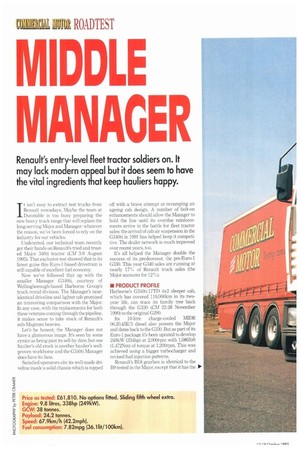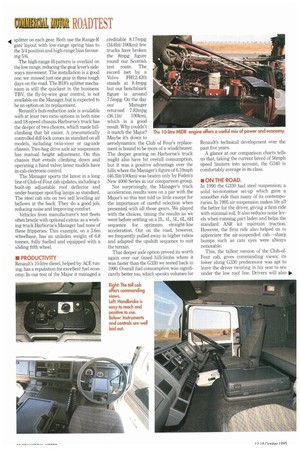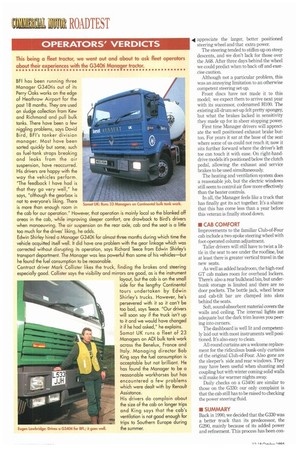MIDDLE MANAGER
Page 38

Page 40

Page 42

Page 43

If you've noticed an error in this article please click here to report it so we can fix it.
Renault's entry-level fleet tractor soldiers on. It may lack modern appeal but it does seem to have the vital ingredients that keep hauliers happy.
/t isn't easy to extract test trucks from Renault nowadays. Maybe the team at Dunstable is too busy preparing the new heavy truck range that will replace the long-serving Major and Manager: whatever the reason, we've been forced to rely on the industry for our vehicles.
Undeterred, our technical team recently got their hands on Renault's tried and trusted Major 340ti tractor (CM 3-9 August 1995). That exclusive test showed that in its latest guise this Euro1 -based drivetrain is still capable of excellent fuel economy.
Now we've followed that up with the smaller Manager G340ti, courtesy of Wellingborough-based Harborne Group's truck rental division. The Manager's nearidentical driveline and lighter cab promised an interesting comparison with the Major. In any case, with the replacements for both these veterans coming through the pipeline, it makes sense to take stock of Renault's sub-Magnum heavies.
Let's be honest; the Manager does not have a glamorous image. It's seen by some cynics as being past its sell-by date; but one haulier's old crock is another haulier's wellproven workhorse and the G340ti Manager does have its fans.
Satisfied operators cite its well-made dri\Feline inside a solid chassis which is topped off with a brave attempt at revamping an ageing cab design. A number of bolt-on enhancements should allow the Manager to hold the line until its overdue reinforcements arrive in the battle for fleet tractor sales: the arrival of cab air suspension in the G340ti in 1991 has helped keep it competitive. The dealer network is much improved over recent years, too.
It's all helped the Manager double the success of its predecessor, the pre-Euro-1 G330. This year G340 sales are running at nearly 17% of Renault truck sales (the Major accounts for 12%).
• PRODUCT PROFILE Harborne's G340ti.17TD 4x2 sleeper cab, which has covered 110,000km in its twoyear life, can trace its family tree back through the G330 (CM 22-28 November 1990) to the original G290.
Its 10-litre charge-cooled MIDR 06.20.45E/3 diesel also powers the Major and dates back to the G330. But as part of its Eum-1 package it's been uprated to develop 249kW (334hp) at 2,000rpm with 1,0861bft (1,472Nm) of torque at 1,200rpm. This was achieved using a bigger turbocharger and revised fuel-injection patterns.
Renault's B18 gearbox is identical to the B9 tested in the Major, except that it has the 110.
splitter on each gear. Both use the Range-R gate layout with low-range spring bias to the 3/4 position and high-range bias favouring 5/6.
The high-range H-pattern is overlaid on the low range, reducing the gear lever's sideways movement. The installation is a good one: we missed just one gear in three tough days on the road. The B18's splitter mechanism is still the quickest in the business. TBV, the fly-by-wire gear control, is not available on the Manager, but is expected to be an option on its replacement.
Renault's hub-reduction axle is available with at least two ratio options in both nine and 18-speed chassis. Harborne's truck has the deeper of two choices, which made hillclimbing that bit easier. A pneumatically controlled diff-lock comes as standard on all models, including twin-steer or tag-axle chassis. Two-bag drive axle air suspension has manual height adjustment. On this chassis that entails climbing down and operating a hand valve; latest models have in-cab electronic control.
The Manager sports the latest in a long line of Club-of-Four cab updates, including a built-up adjustable roof deflector and under-bumper spot/fog lamps as standard. The steel cab sits on two self levelling air bellows at the back. They do a good job, reducing noise and improving comfort.
Vehicles from manufacturer's test fleets often bristle with optional extras: as a working truck Harborne's Manager had none of these fripperies. This example, on a 3.6m wheelbase, has an unladen weight of 6.8 tonnes, fully fuelled and equipped with a sliding fifth wheel.
• PRODUCTIVITY Renault's 10-litre diesel, helped by ACE tuning, has a reputation for excellent fuel economy. In our test of the Major it managed a creditable 8.17mpg (34.61it/-1001cm): few trucks have broken the 8mpg figure round our Scottish test route. The record (set by a Volvo FH12.420) stands at 8.4mpg but our benchmark figure is around 7.5mpg. On the day our Manager returned 7.82mpg
(36.11it/ 100km), which is a good result. Why couldn't it match the Major? Maybe it's down to aerodynamics: the Club of Four's replacement is bound to be more of a windcheater. The deeper gearing on Harborne's truck might also have hit overall consumption, but it was a positive advantage over the hills where the Manager's figure of 6.10mph (46.31ft/100km) was beaten only by Foden's New 4000 Series in our comparison group.
Not surprisingly, the Manager's track acceleration results were on a par with the Major's so this test told us little except for the importance of careful selection when presented with all those gears. We played with the choices, timing the results as we went before settling on a 2L, 4L, 5L, 6L, 6H sequence for optimum straight-line acceleration. Out on the road, however, we frequently pulled away in higher ratios and adapted the upshift sequence to suit the terrain.
That deeper axle option proved its worth again over our timed hillclimbs where it was faster than the G330 we tested back in 1990. Overall fuel consumption was significantly better too, which speaks volumes for
Renault's technical development over the past five years.
A glance at our comparison charts tells us that, taking the current breed of 56mph speed limiters into account, the G340 is comfortably average in its class.
• ON THE ROAD.
In 1990 the G330 had steel suspension; a solid no-nonsense set-up which gave a smoother ride than many of its contemporaries. In 1995 air suspension makes life all the better for the driver, giving a firm ride with minimal roll. It also reduces noise levels when running part laden and helps the standard ASR kit maintain traction. However, the firm ride also helped us to appreciate the air-suspended cab—sharp bumps such as cats eyes were always noticeable.
This, the tallest version of the Club-ofFour cab, gives commanding views; its lower slung G330 predecessor was apt to leave the driver twisting in his seat to see under the low roof line. Drivers will also appreciate the larger, better positioned steering wheel and that extra power.
The steering tended to stiffen up on steep descents, and we don't lack for those over the A68. After three days behind the wheel we could predict when to back off and exercise caution.
Although not a particular problem, this was an annoying limitation to an otherwise competent steering set-up.
Front discs have not made it to this model; we expect them to arrive next year with its successor, codenamed H100. The existing all-drum set-up felt pretty spongey, but what the brakes lacked in sensitivity they made up for in sheer stopping power.
First time Manager drivers will appreciate the well positioned exhaust brake button. For years it sat at the base of the seat where some of us could not reach it; now it sits further forward where the driver's left toe can touch it with ease. On right-handdrive models it's positioned below the clutch pedal, allowing the exhaust and service brakes to be used simultaneously.
The heating and ventilation system does a reasonable job, but the electric windows still seem to control air flow more effectively than the heater controls.
In all, the Manager feels like a truck that has finally got its act together. It's a shame that this has come less than a year before this veteran is finally stood down.
• CAB COMFORT Improvements to the familiar Club-of-Four cab include a two spoke steering wheel with foot-operated column adjustment.
Taller drivers will still have to twist a little in the seat to see under the roofline, but at least there is greater vertical travel in the new seats.
As well as added headroom, the high-roof GT cab makes room for overhead lockers. There's also a rear bulkhead bin, but underbunk storage is limited and there are no door pockets. The bottle jack, wheel brace and cab-tilt bar are clamped into slots behind the seats.
Soft, sound-absorbent material covers the walls and ceiling. The internal lights are adequate but the dark trim leaves you peering into corners.
The dashboard is well lit and competently laid out with most instruments well positioned. It's also easy to clean.
All-round curtains are a welcome replacement for the ridiculous bunk-only curtains of the original Club-of-Four. Also gone are the sleeper's side and rear windows. They may have been useful when shunting and coupling but with winter coming solid walls will make for warmer nights away.
Daily checks on a G340ti are similar to those on the G330: our only complaint is that the cab still has to be raised to checking the power steering fluid.
• SUMMARY Back in 1990, we decided that the G330 was a better truck than its predecessor, the G290, mainly because of its added power and refinement. This process has been con tinued with the G340, which also manages better fuel economy. Moving to Euro-1 has done this truck no harm.
We also described the G330 as a solid fleet motor, but not much else. That's still the case. Cab air suspension and the latest interior are simply an attempt to match the standards set by more recent competitors in a design which dates back to the 1970s.
As a sleeper cab it's still got more going for it than the Volvo FL10 but that hasn't stopped the FL10 heading the fleet tractor sales league. In this market sector productivity will always be more important than cab comfort.
However, when it comes to looking after the driver the Manager is certainly on a par with its fleet rivals. The engine is flexible, noise levels are low and handling and manoeuvrability are good. From the operator's point of view the G340ti represents a productive, dependable package which offers good coupling dimensions from a variety of wheelbases.
Like the G330, the G340ti ranks as a midfield player with some useful refinements. This is no Scania-killer, but it a good basic truck which will earn its keep in a hardworking fleet.
At today's discounted prices, the company accountant will certainly love it. Some drivers may still wince at the name Renault, but this is one gaffer's motor that could earn their respect.
This design is nearing the end of its service life. But, thanks to some well-considered refinements, the Manager should help Renault maintain its share of a tough market sector until the reinforcements arrive. U by Danny Coughlan




















































































































